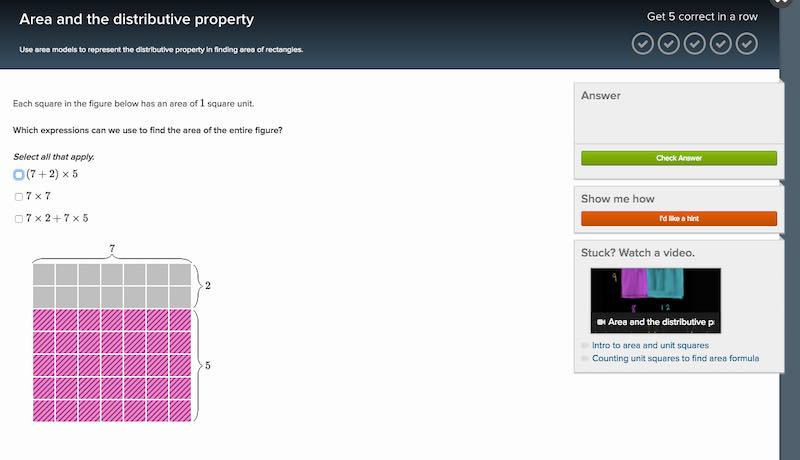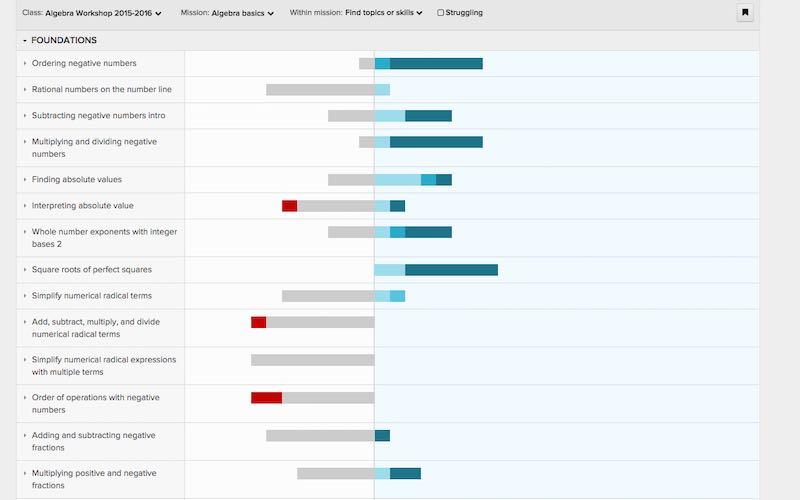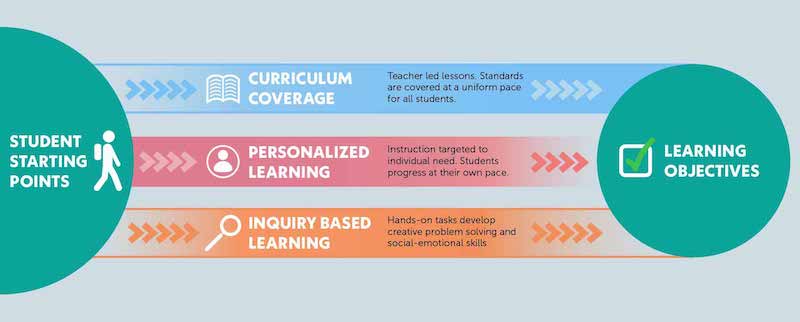How To Add Students To Khan Academy Class
When I get-go started education math, I had a problem. I gave my 5th graders the pre-assessment from the textbook, and the whole form bombed. At the time, I'd never considered using Khan University every bit a classroom tool.
Sure, information technology was great to know that they struggled with place value and whole number operations. But what was I supposed to practice with this data? The starting time chapter of the textbook expected them to practise multi-step word problems with decimals. And I didn't accept another resource to teach from.
Khan Academy and the Personalized Learning Classroom
I had long been daydreaming about developing an online math program. It would ask questions to identify what a student could already do. Then, information technology would assign whatever they needed to piece of work on next.
One mean solar day, I was talking with the engineering director at my school. I explained the problem with my math class, and told him nigh my idea. He said he had skilful news and bad news. The bad news was that my idea was far from original. The good news was that I could first using Khan Academy in my classroom correct abroad, for gratis.
Soon, Khan Academy became a regular part of our classroom routine. And the results were astounding. I was no longer jump to teach every child the same lesson, at the same time, on the same day.
More importantly, my students felt less pressure to "perform" math and compete with each other. Instead, they started to enjoy math. As each found the level that was right for them, students who had struggled got the support they needed. Students who had been bored were challenged, tackling work from higher grade levels.
Overcoming Objections
Of course, it wasn't all sunshine and roses. Any major change comes with hidden challenges. Over fourth dimension, I gradually tweaked how I was using Khan in class. As well as the way I assessed their piece of work on the platform. But in that location was also some initial resistance to the whole thought of personalized learning.
When the program assigned work that was ii or 3 years "below class level," the students didn't mind. They were grateful to learn material that was accessible to them. The parents, on the other hand, weren't always then understanding. Some questioned whether it was right for students to work on computers in school. Others challenged the accuracy of the cess.
Only when I invited parents in to see what a Khan Academy classroom looked like, well-nigh came around. They saw their children actively engaged and having fun. Students were calling me over to ask questions or having vibrant math conversations with each other.
It was nothing like what the skeptical parents had imagined. (Kids sitting zombified in rows. Me out in the hall drinking coffee and shooting the breeze with other teachers.)
And when our tests scores came back, information technology was clear that personalized learning was working. Our average score (on the ERB) had jumped from the low 40th percentile to the low 60th. Our superlative students had gone from the 70th percentile to the 90th. But the well-nigh growth came from the struggling students. Many had started the twelvemonth in single-digit percentiles. In one year, most had moved into the teens. A few were in the 30'southward and twoscore'due south.
I'm happy to see similar results in other schools that adopt this approach. The fundamental is setting aside class time every week for Khan Academy missions. Classes that brand the commitment, meet growth in accomplishment and engagement.
So What Is Khan Academy?
Khan Academy is an online adaptive math platform. "Adaptive" considering it uses an algorithm to adapt to student needs. A instructor doesn't even need to assign piece of work. The platform figures out the best topic for each student to piece of work on. Information technology gives students a problem set, tells them how they did on information technology, and passes the data on to the teacher.
There are many online math platforms now available to schools – some adaptive, some not. But I think Khan Academy is the best, not least because it's free.
I've written previously nigh what to consider when choosing an online math platform. While Khan Academy meets all the basic criteria, it goes well beyond the basics.
Khan Academy'due south fundamental features are its mission : to bring a world-class education to anyone, anywhere. And its Missions : the "product" (part of their site) that generates personalized recommendations and data.
Khan Academy has also introduced a "product" that aims to mix personalized and teacher-centered learning. Called "Mastery," it promises to conform to student demand while also keeping students focused on class-level content. As yous tin imagine, it's not piece of cake to foursquare that circle. Fortunately, Missions is still bachelor, but you do have to wait for it.
Sal Khan's Passion for Personalized Learning
Khan University began as a labor of beloved from Salman Khan to aid his niece. Information technology has grown to get a world-wide phenomenon. Rather than spending time and money on marketing, Khan University is a not-turn a profit. It focuses merely on providing a high-quality gratis product.
In his TED talk , Salman Khan describes the fundamental trouble facing today's schools: scale. To educate many students at once, teachers march through content at a uniform pace. Rather than teaching for mastery, nosotros measure understanding in percentages. One time the teacher "covers" a topic, the grade moves on to the side by side.
This model is centered around curriculum and standards, not on educatee needs. Information technology eventually creates gaps for some students that forbid future learning. Other students learn new content quickly and go bored or disengaged. In either case, past center or high school, many students feel frustrated by their schools' inability to meet their individual needs.
This was the exact event I was facing with my math students. And the more I talked with other educators, the more I realized we are all experiencing the aforementioned struggle. The problem wasn't teachers not caring enough, or even not differentiating plenty. It's a systemic issue, built right into the way that schools are designed.
The Benefits of Khan University in the Classroom
Using Khan Academy isn't most replacing teachers. And it's non nearly having students spend every twenty-four hours on computers. It's well-nigh providing teachers with options.
Teachers who use Khan Academy in their classrooms can permit each student to progress at a comfy pace. They can address gaps from prior class levels and accelerate ambitious high achievers.
Here are some of the virtually compelling benefits of personalized learning.
Increased Student Ownership
When students work at their own levels, they develop a healthier relationship with math.
1 reason why Khan Academy missions are so effective is that they give students control over their learning. Teachers can notify students to start a "mission" (grade level). But students can even so choose to explore dissimilar levels or topics.
Some see this as a problems, but I run into it as a feature. Students lose motivation when they are don't have any selection in their learning. When we give students ownership, some volition make poor choices. But these twists and turns go crucial life lessons.
Helping students set up goals and manage difficulties is what personalized learning is all about. And in the long run, this approach supports both academic and social-emotional learning.
Reduced Teacher Workload
Using an adaptive platform like Khan University saves teachers prep time in two means.
First, when students spend one to two classes per week on Khan Academy, that'southward 2 less lessons to program. And these lessons aren't merely filler. They're highly engaging and completely differentiated.
I have students take an inquiry-based approach to using Khan Academy. Rather than watching videos, I encourage them to focus on problem sets. Students employ reasoning or trial-and-error to learn new skills. Only when they desire assistance, practice I encourage them to employ the built-in 'hints' and 'videos' as a resource.

Inquiry-based learning has been scientifically proven to support improved pupil outcomes in several areas. The results are clear: deeper understanding, better retention, and increased appointment.
Khan University also saves teachers fourth dimension on grading. Students receive instant feedback, which has a number of benefits. The research of Mihaly Csikszentmihalyi has shown that instant feedback is fundamental to creating "flow states." Flow states are defined by extreme happiness and intense learning curves.
Khan besides records data on educatee operation in a manner that's like shooting fish in a barrel for teachers to interpret. (And to copy into their grade books). This further reduces the time teachers spend on paperwork each week.
Increased Student Performance
Perhaps the greatest benefit is Khan University's impact on student achievement.
Part of the reason personalized learning is then constructive is that information technology addresses "the iceberg trouble." Typical assessments measure out students confronting a uniform standard. For example, 'Harold has mastered 60% of the unit of measurement on fractions.'
But this type of information is just the tip of the iceberg. Such assessments may exist useful for evaluating teachers and schools. But it does lilliputian to help teachers help struggling students. To use assessment to inform instruction, we demand to know why a student is struggling. The answer normally lies in foundations from prior grade levels.
Khan Academy'south power to see beneath the surface is a large piece of how it supports achievement. The plan also allows students to motion at their own footstep. Combined, these two innovations are central to the platform'southward affect.
Personalized Learning, Traditional Schools
While its designers originally made Khan Academy for contained abode use, it is fast becoming a popular classroom tool. Teachers can utilize Khan University equally a standalone tool. Or they can employ it to inform planning of whole group and pocket-size group lessons.

The student-centered philosophy is still reflected in the design of the platform. Just it can be challenging to make personalized learning work in traditional schools. Almost all schools are congenital on a curriculum-coverage model. Nosotros wait teachers to "cover content." Nosotros expect students to "go on up."
Every bit I've introduced Khan Academy to more than classrooms, I've seen the challenges first-hand. Some teachers experience that personalized learning takes away class time needed for grade level work. Others just override the algorithm and assign every student the same activity. While this approach is marginally better than a worksheet, information technology's certainly not personalized.
Others use Khan Academy just for homework. Again, better than worksheets. Only information technology however sends the bulletin that what matters is course level piece of work. Unit tests and standardized tests count. Private needs remain the student'due south responsibility. Something done outside the classroom.
For students to get the full benefits, personalized learning should be a part of the weekly routine. Even i period a calendar week can practice wonders for students' conviction and competence in math.
The Three-Bridges Design for Learning.
These challenges inspired me to create the Three-Bridges Design for Learning. The thought is that different teaching strategies promote different outcomes.

Information technology'due south quite simple, really. If we want to meet individual pupil needs, we demand to measure out (and value) individual growth. A student who gains two grade levels in ane year is an enormous success — even if she ends the year below grade level. A pupil who starts out ane year above grade level and learns nothing shouldn't be considered a success — even if he passes the exam.
Schools likewise need curriculum plans that build-in time for personalized learning. Many schools are amazed at how efficiently they can cover content…when they have a customized curriculum map.
Creativity, Collaboration, and Conceptual Learning
Schools that implement Three-Bridges Blueprint increase student appointment and achievement. For more than stories about innovative pedagogy strategies, subscribe to our Educator's Newsletter.
Y'all can as well bring together educators from around the earth in our Facebook customs . We're defended to bringing creativity, collaboration, and conceptual learning to every student, in every classroom.
Subscribe to our newsletter today, and you lot'll receive a costless re-create of our Personalized Learning Quick-Outset Guide.
GET YOUR FREE QUICK-Get-go GUIDE
How To Add Students To Khan Academy Class,
Source: https://roomtodiscover.com/khan-academy-math-classroom/
Posted by: aginpegare.blogspot.com


0 Response to "How To Add Students To Khan Academy Class"
Post a Comment